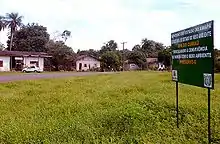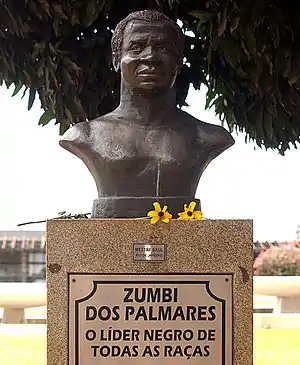Quilombo
A quilombo (Portuguese pronunciation: [kiˈlõbu]; from the Kimbundu word kilombo, "war camp")[1] is a Brazilian hinterland settlement founded by people of African origin, and others sometimes called Carabali. Most of the inhabitants of quilombos, called quilombolas, were maroons, a term for escaped slaves.


Documentation about refugee slave communities typically uses the term mocambo for settlements, which is an Ambundu word meaning "war camp". A mocambo is typically much smaller than a quilombo. The term quilombo was not used until the 1670s, and then primarily in the more southerly parts of Brazil.
In the Spanish-speaking countries of Latin America, such villages or camps were called a palenque. Its inhabitants are palenqueros. They spoke various Spanish-African-based creole languages such as Palenquero.
Quilombos are classified as one of the three basic forms of active resistance by enslaved Africans. They also regularly attempted to seize power and conducted armed insurrections at plantations to gain amelioration of conditions.[2] Typically, quilombos were a "pre-19th century phenomenon". In the first half of the 19th-century in Brazil, slaves typically took armed action as part of their resistance. The colony was undergoing both political transition, as it fought for independence from Portugal, and new tensions associated with an increased slave trade, which brought in many more native-born Africans, who resisted slavery.
Lives of slaves
Legal slavery was present in Brazil for approximately four centuries, with the earliest known landing of enslaved Africans taking place 52 years after the Portuguese were the first Europeans to set foot in Brazil in 1500.[2] The demand for enslaved Africans continued to increase through the 18th century, even as the Brazilian sugar economy ceased to dominate the world economy. In its place, commodity crops such as tobacco increased in prominence.[3]
During the sugar boom period (1570–1670), the sugar plantations in Brazil presented hellish conditions, even including the personal brutality of some slave owners. There was high physical exertion on workers, especially during harvest season. In addition, enslaved people were held to nearly-impossible daily production quotas while having to contend with lack of rest and food. Economically in sugar plantations, it was cheaper for owners of enslaved Africans to work them to death and get new replacement enslaved people.[4] Conditions were so bad that even the Crown intervened on at least two occasions, forcing plantation owners to give their slaves sufficient food.[3]
History
- See Atlantic slave trade for a comprehensive presentation of slavery in Brazil
Settlements were formed by enslaved Africans who escaped from plantations. Some slave owners, such as Friedrich won Weech, regarded the first escape attempt as a part of "breaking in" process for new slaves. The first escape attempt would be punished severely as a deterrent for future escapes. Slaves who tried to escape a second time would be sent to slave prison, and those who tried a third time would be sold.[5] In general, slaves who were caught running away were also required to wear an iron collar around their necks at all times, in addition to the punishment they received.
Not all slaves who ran away formed settlements in Brazil. Escape from a life of slavery was a matter of opportunity. Settlements were formed in areas with dense populations of slaves, like Pernambuco, where the biggest collection of mocambos formed the quilombo that became Palmares. While many quilombos were formed in rural areas such as Palmares, some were formed inside of cities, such as the pt:Quilombo de Leblon inside of Rio de Janeiro.[6] Some, among them Mahommah G. Baquaqua, escaped to New York because his multiple attempts at escape and suicide led to him being sold to a ship's captain.[7]
It is widely believed that the term quilombo establishes a link between settlements and the culture of West Central Africa from where the majority of slaves were forcibly brought to Brazil. During the era of slave trafficking, natives in central Angola, called Imbangala, had created an institution called a kilombo that united various tribes of diverse lineage into a community designed for military resistance.
Many quilombos were near Portuguese plantations and settlements. To keep their freedom, they were active both in defending against capitães do mato and being commissioned to recapture other runaway slaves. At the same time, they facilitated the escape of even more enslaved persons.[8] For this reason, they were targets of the Dutch, then Portuguese colonial authorities and, later, of the Brazilian state and slave owners.
Despite the atmosphere of cooperation between some quilombos and the surrounding Portuguese settlements, they were almost always eventually destroyed. Seven of 10 major quilombos in colonial Brazil were terminated within two years of formation. Some mocambos that were farther from Portuguese settlements and the later Brazilian cities were tolerated and still exist as towns today, with their dwellers speaking Portuguese Creole languages.[9]
Quilombos
Palmares
The most famous quilombo was Palmares, an independent, self-sustaining community near Recife, established in about 1600. Palmares was massive and consisted of several settlements with a combined population of over 30,000 citizens, mostly blacks. It was the only quilombo to survive almost an entire century, with the second longest-standing quilombo, in Mato Grosso, lasting only 25 years.[10] Part of the reason for the massive size of the quilombo at Palmares was because of its location in Brazil, at the median point between the Atlantic Ocean and Guinea, an important area of the African slave trade. Quilombo dos Palmares was a self-sustaining community of escaped slaves from the Portuguese settlements in Brazil, "a region perhaps the size of Portugal in the hinterland of Bahia".[11]
At its height, Palmares had a population of over 30,000. Forced to defend against repeated attacks by Portuguese colonists, the warriors of Palmares were experts in capoeira, a dance and martial art form.
Ganga Zumba and Zumbi are the two best-known warrior-leaders of Palmares which, after a history of conflict with first Dutch and then Portuguese colonial authorities, finally fell to a Portuguese artillery assault in 1694. Portuguese soldiers sometimes stated it took more than one dragoon to capture a quilombo warrior since they would defend themselves with a strangely moving fighting technique (capoeira). The governor from that province declared that "it is harder to defeat a quilombo than the Dutch invaders".
In Brazil, both men are now honored as heroes and symbols of black pride, freedom, and democracy. As his birthday is unknown, Zumbi's execution date, November 20, is observed as Dia da Consciência Negra or "Black Awareness Day" in the states of Rio de Janeiro and São Paulo, and his image has appeared on postage stamps, banknotes, and coins.
Mola
The Mola quilombo consisted of approximately 300 formerly enslaved people and had a high degree of political, social and military organization.[12] Felipa Maria Aranha was the first leader of the community.[13] The group was also led by Maria Luiza Piriá.[14] It was organised as a republic, with democratic voting in place.[15] Over the course of the Mola quilombo's life, it expanded to include four other similar settlements in the region and was known as the Confederação do Itapocu.[16][14] In 1895 there were still traces of the settlement to be seen; as of 2020, they had disappeared.[17]
Movie
A 1984 film entitled Quilombo[18] depicts the rise and fall of Palmares. Directed by Carlos Diegues, Quilombo is a historical epic that chronicles the lives of Ganga Zumba and Zumbi.
Constitution of Brazil
Article 68 of the 1988 Constitution of Brazil granted the remaining quilombos the collective ownership of the lands they had occupied since colonial times.[19]
In Castilian
In South American Spanish of the Southern Cone the word quilombo has come to mean brothel; in Argentina, Bolivia, Honduras, Paraguay and Uruguay, a mess, noise or disorder; in Venezuela, a remote or out-of-the-way place.[20]
See also
References
- A. de Assis Junior, "Kilómbo", Dicionário kimbundu-português, Luanda Argente, Santos, p. 127
- Kent, R. K. (1965). "Palmares: An African State in Brazil". Journal of African History. 6 (2): 161–175. doi:10.1017/s0021853700005582. JSTOR 180194.
- Schwartz, Stuart B. (Summer 1970). "The "Mocambo": Slave Resistance in Colonial Bahia". Journal of Social History. 3 (4): 313–333. doi:10.1353/jsh/3.4.313.
- "The plantation economy | West Indies | The Places Involved | Slavery Routes | Bristol and Transatlantic Slavery | PortCities Bristol". discoveringbristol.org.uk. Retrieved 2016-01-18.
- Karasch, Mary C. (1987). Slave Life in Rio de Janeiro 1808–1850. New Jersey: Princeton University Press. p. 303. ISBN 978-0-691-07708-6.
- Talarico, Bruna. "Quilombo no Leblon foi o primeiro abolicionista no país". Palmares.
- Moore, Samuel (1854). Biography of Mahommah G. Baquaqua. Detroit.
- Shore, Edward (2017). "Geographies of Resistance: Quilombos, Afro-descendants, and the Struggle for Land and Environmental Justice in Brazil's Atlantic Forest". Afro - Hispanic Review. 36 (1): 58–78. ProQuest 2076933136.
- MG Quilombo
- Kent (1965). "Palmares: An African State in Brazil". Journal of African History. 6 (2): 163. doi:10.1017/s0021853700005582. JSTOR 180194.
- Braudel, Fernand, The Perspective of the World, vol. III of Civilization and Capitalism, 1984, p. 390.
- "Tucuruí - Informações, Imagens e Vídeos". Amazônia (in Portuguese). Retrieved 2021-01-02.
- Galeano, Eduardo, 1940–2015. Children of the days : a calendar of human history. London. ISBN 1-56858-971-9. OCLC 895700030.CS1 maint: multiple names: authors list (link)
- "Brasil de Fato". Brasil de Fato (in Portuguese). Retrieved 2021-01-02.
- "Quilombolas: quem são, origem, tradição, condições". Brasil Escola (in Portuguese). Retrieved 2021-01-02.
- Guimarães, José (2012). «Settlement in Southern Pará and Historical Origins of the Carajás Movement». Carajás Youth Debates (interview). Interview with Teixeira de Souza, M .. Teixeira de Souza, M. Belém.
- Moura, Clóvis. (2004). Dicionário da escravidão negra no Brasil. São Paulo, SP, Brasil: Edusp. p. 47. ISBN 85-314-0812-1. OCLC 62236622.
- Quilombo at IMDb
- Brooke, James (1993-08-15). "Brazil Seeks to Return Ancestral Lands to Descendants of Runaway Slaves". The New York Times. ISSN 0362-4331. Retrieved 2016-12-06.
- Dictionary of the Royal Spanish Academy, "quilombo", senses 1, 2 and 3, respectively.
Further reading
- Glenn Alan Cheney, Quilombo dos Palmares: Brazil's Lost Nation of Fugitive Slaves, Hanover, CT:New London Librarium, 2014.
- Phillips, Dom (March 5, 2018). "Their forefathers were enslaved. Now, 400 years later, their children will be landowners. Rare victory for Brazilian poor, as record Amazon land tract is handed over to descendants of escaped enslaved people". The Guardian. Retrieved 2018-03-05.
External links
- The Quilombo of Remanso
- The Quilombo of Palmares: A New Overview of a Maroon State in Seventeenth-Century Brazil (scholarly article)
- Fugitive Slaves and Free Society: The Case of Brazil (scholarly article)
- Buried Alive: Imagining Africa in the Brazilian Northeast (scholarly article)
- Oppression & Rebellion: The Quilombo at Palmares (scholarly article)
- Articles and sources for quilombos in Brazil
- Maroon community in Colombia
- Voice_of_the_Leopard
- Discovering Rio's Little Africa
![]() Media related to Quilombos at Wikimedia Commons
Media related to Quilombos at Wikimedia Commons
